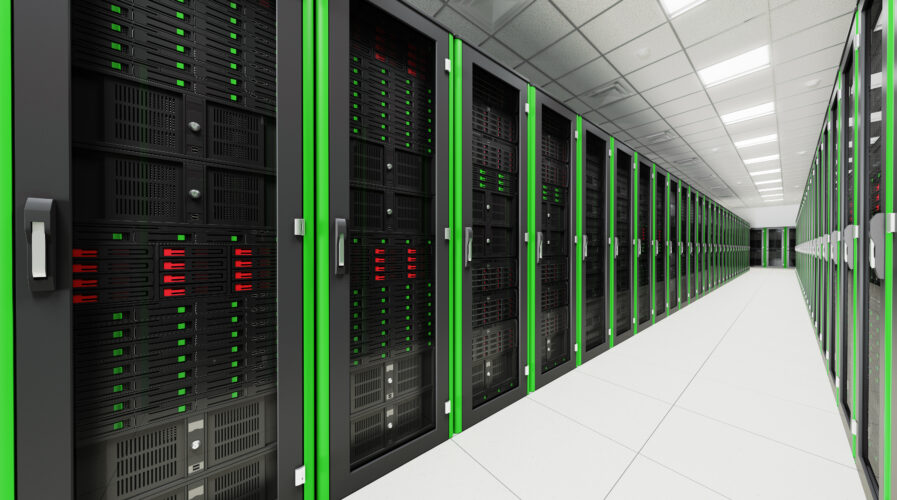
(Source – Shutterstock)
Contextualizing data center sustainability: The role of cloud
Article by Dr Fraser Thompson, Principal at Access Partnership and co-founder of AlphaBeta (part of Access Partnership) and Abhineet Kaul, Director at AlphaBeta.
By some estimates, data centers around the world today use approximately 200-terawatt hours (TWh) of energy each year. In the most extreme scenario, if left to grow unchecked, by 2040, data storage could account for 14% of global emissions, matching the current emissions of the United States. In this scenario, would surging demand for digital services create challenges for countries seeking to achieve sustainability targets?
The answer is no; in fact, the megatrends of digitalization and sustainability are interlinked and reinforcing. As action towards the goals of the Paris Agreement and the UN Framework Convention on Climate Change accelerates, the implementation of a data-driven digital transformation agenda should be a priority for effective investment in sustainability.

Dr Fraser Thompson, Principal at Access Partnership and co-founder of AlphaBeta
Massive investments in energy efficiency and renewable energy by cloud service providers are already rapidly decreasing emissions from running IT workloads in the cloud. Furthermore, a recent report by the International Energy Agency (IEA) found that the cloud can itself accelerate innovation processes. This includes leveraging cloud-enabled technologies such as artificial intelligence (AI) or machine learning (ML) and real-time analytics to plot more fuel-efficient air routes, save water through better utility systems management, and scale the integration of renewable energy resources on the grid. Close to 40% of all targets under the UN Sustainable Development Goals (SDGs) are also dependent on or enabled by data-driven, cloud-led solutions.
At a recent gathering of public and private sector sustainability experts from across the Asia Pacific region organized by Amazon Web Services (AWS), we shared findings on how to turn the parallel challenges of digitalization and decarbonization into mutual opportunities. The key solution discussed was harnessing the power of and demand for cloud technology to meet climate commitments.
Our Green Data: The sustainable data center opportunity for Singapore report highlighted how data centers create and support over SG$2 billion in Singapore’s annual GDP and enable up to 1.6 million indirect jobs dependent on cloud technology. The “Green Growth” scenario for data centers presented in the report outlines a pathway for countries to achieve economic success without compromising sustainability goals. In this scenario, data center operators focus more on sustainability performance through increasing computing power, improving power usage efficiency, using 100% renewable energy, and adopting efficient approaches to cooling, such as liquid cooling. This is similar to the European Union’s Climate Neutral Data Centre Pact that APAC can also learn from.
In our expanded report, Global Data Center Policy and Sustainability Report, we shared survey results derived from over 100 interviews with global executives in the data center industry, in which over 90% highlighted that sustainability is an utmost priority for their businesses. Interestingly, 84% of respondents are prioritizing sustainability investments due to organizational goals, or those of clients, rather than in response to regulatory pressures. This suggests establishing industry-wide norms around prioritizing data center sustainability is an important complement to policy discussions, and could be a focus of future public-private dialogues.
Moving Forward
Green data centers will continue to be crucial for digital transformation. In economic terms, the Green Growth model represents an opportunity to expand digitalization while mitigating the environmental impacts of data center growth. In this scenario, the ability of economies to provide favorable environments for data centers becomes a competitive advantage. Aided by stable, continuous access to clean energy, treated wastewater for cooling, and sustainable supply chains, a green data center ecosystem needs ambitious, cross-industry collaborative models to ensure we meet our economic and sustainability goals.
The views in this article is that of the authors and may not represent the views of Tech Wire Asia.
READ MORE
- The criticality of endpoint management in cybersecurity and operations
- Ethical AI: The renewed importance of safeguarding data and customer privacy in Generative AI applications
- How Japan balances AI-driven opportunities with cybersecurity needs
- Deploying SASE: Benchmarking your approach
- Insurance everywhere all at once: the digital transformation of the APAC insurance industry


